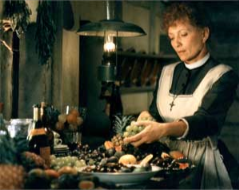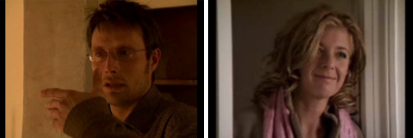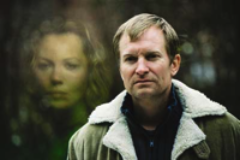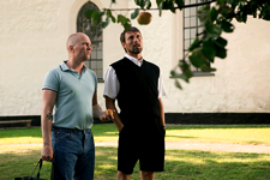Letter from Yvonne: Danish Cinema For Beginners

Hello to everyone!
I began fretting over how to title this entry long before I finally launched into writing it. How to communicate that I’m going to write about Danish Cinema without stirring up hope that I may have brilliant and scholarly things to say about Danish Cinema? Oh, believe me, I would love to offer scholarly observations on…perhaps, the seminal work and international influence of Carl Theodor Dreyer, but I’ve only ever seen Vampyr, and that was forever ago, and I’m pretty sure I thought he was German. If you’re curious about how the French New Wave inspired the Dogme 95 Collective, I’ll have to beg off again, as I’ve not seen enough of the Dogme films to speak about them with any authority…and of the six I have rented, I kind of hated two of them.
So this post could only truthfully be titled “Here Are Some Post-Babette’s Feast Danish Films That I Have Found at Netflix, and Enjoyed, and Would Like to Recommend to You in the Hope That You Will Like Them Also”.
Netflix has been very good to me since I joined a year ago, so I hate to complain, but their selection of Danish films — my only source for them, unfortunately — is random, and uneven in quality. And they’ve made life difficult for an eager Danish Cinema maven-wannabe: there is neither a proper listing of their Danish films, nor a reliable search strategy for them. If one searches under “Danish Language”, only a few from Netflix’ own collection are displayed…and not even the best of them; one must search for individual titles, actors or directors.

My first Danish film may have also been your first Danish film: Babette’s Feast, which I saw in a theater when it was released in the US in 1987 (or 88?). What a buzz it created, with its comforting message about the nobility of The Artist, and featuring a beautiful heroine, wit, wisdom, opera…and, more to the point, lots of glorious food. There were Babette’s Feast parties, in which the guests all trooped off to see the movie on a Friday night, in anticipation of Saturday night, when the menu so lovingly prepared by Babette was recreated in the host’s kitchen. At our theater, Xeroxed copies of recipes for all the dishes were handed out at the door.
(Did any of you attend one of those parties? If you have ever tasted — or, good heavens, cooked — Cailles en Sarcophages: that’s what the comment area below is for. Do tell us, please!)
My husband and I watched Babette’s Feast over the Thanksgiving weekend. I hadn’t seen it in years, and was surprised to find that it had changed for me: rather than a Foodie film, I found it a quintessentially Danish film, now that I have the eyes to recognize one. The buoyant spirit, clean cinematography, wonderful acting, the impeccable details. Does anyone else find it thrilling when Babette unfurls that crisp white tablecloth, which she’s folded so that it may be pulled quickly and smoothly from one end of the long table to the other? And then she takes the iron to it, because some small things in life are perfectible. (Ha! — behind her, one of the sisters silently hustles away the minister’s portrait!) How about when Babette works her fingers briskly through her young assistant Erik’s red hair in that volumizing way that hair stylists do, just before she sends him out to begin serving her masterpiece of a meal? And I can’t tell you how much I love the moment when she’s sitting alone afterward, in a dazed state of deep satisfaction: she’s sitting, in her long dress, like a man — no, like a male athlete, exhausted but savoring an important victory.
Love her penniless-servant’s uniform — designed by Karl Lagerfeld.
(By the way, if you’re a Feast fan, I recommend reading the Isak Dinesen short story upon which the film is based: you’ll find our Babette even more mysterious and intriguing, if several degrees less cuddly. [Don’t want to spoil anything…I’ll just say that, smart as y’all are, you won’t even need to look up the word pétroleuse, as I did. Ahem.] )
After 1988, I doubt that I gave another thought to the cinematic contributions of Denmark until the news of Dogme 95 emerged in the mainstream American press.  I don’t recall being particularly interested; an artists’ manifesto, with a list of rules?…dogma? By the time I’d seen a couple of the abusive films of Lars von Trier, the first and most famous of the signatories, I was glad I’d paid no attention.

So it wasn’t until recently that I became curious about what those Danes were up to — After the Wedding (Efter bylluppet) was the one that got my attention. In this film, a dedicated relief worker in Mumbai reluctantly returns to his native Denmark to secure funding for his school/ orphanage; the wealthy potential donor who’s summoned him has ulterior motives. The DVD is widely available in the US, and I think it’s the best way to begin an obsession with Danish cinema. (R J’s review is here.)
The film also rescued Mads Mikkelsen from eternal ex-Bond Villain-hood — for movie fans in the US, that is; he’s actually one of the most successful actors in Denmark. And he is mesmerizing. Talented, graceful, handsome — or, better than handsome: he is joli-laid, a fascinating thing for an actor to be — he’s become one of my favorites. If you missed Debra Winger while she was away from American movies, After the Wedding’s female lead, Sidse Babett Knudsen, will win you over as well.
A search for information about the film’s director, Susanne Bier, finally nudged me to learn a bit about Dogme 95 — for that’s where Bier began. My very first red Netflix envelope contained her 2002 film, Open Hearts (Elsker dig for evigt), aka Dogme #28.
Much analysis of Dogme (which officially disbanded in 2005) is available online, so I’ll be brief in my summary: Dogme 95 took a stand against the excesses of big-budget movies — the bloated salaries, the emphasis on expensive special effects rather than story. Among the technical rules, called “Vows of Chastity”, were these: Films were to be shot on location, without the importation of props, with hand-held cameras; in natural light and with available sound. (No fair sweetening a scene with emotional music during post-production, for example.) Lo, I hope it will bring you comfort, as it has me, to learn that none of the certified Dogme films, not even the very first one, adhered completely to the strictly-stated rules. Hee. (The directors wrote out formal “confessions” of their transgressions. “I moved a candle.”)
Other rules dealt with content. There were to be no genre films or period pieces; which leaves…here, and now. Also: no weapons! Imagine! If there’s a conflict between two characters, one cannot just shoot the other and be done with it! And in Dogme films, the drama is invariably pitched high, and is character-driven, with plenty of conflict to go round.
If you’ve not seen a Dogme film, I’ll recommend two that did quite well in the US. In The Celebration (Festen), the first official Dogme film, family and friends gather in honor of the patriarch’s birthday; during the course of a very long evening, painful family secrets are exposed. At the other end of the spectrum, the most light-hearted of the early Dogme films is Italian for Beginners (Italiensk for begyndere), in which an adult-learning class brings together a group of lonely people.

I also recommend the aforementioned Open Hearts. Mads Mikkelsen and another favorite, Paprika Steen (above), stunned me in this one. They play a married couple with three kids whose lives are blown apart in the wake of a devastating accident. I will admit that I appreciated the performances in this film more than I enjoyed watching the harrowing story…
…which brings me to the two charges most frequently leveled against Danish films: 1) They are depressing. 2) They are melodramatic to a distracting extent. To which I respond: 1) They don’t depress me, but I understand. And 2) Oh, man, you are so right about that! On any internet film forum site one is sure to find a reviewer opining that the Danish film he or she just watched wasn’t “realistic”. This guarantees an avalanche of snark in return (“LOL, yeah, right, coz Star Wars really happened”)…but I get what the critic means. In Danish films, the situations are often extreme, sometimes pure soap-opera. There seem to be a lot of mental health issues: we can expect, in any Danish film, at least one over-the-top freak-out by a character under pressure. Or the plot might begin to creak under the weight of an exasperatingly predictable cliché…or an improbable coincidence might be necessary to keep the story from imploding.
And yet, these films work — and sometimes haunt one for weeks afterward — because the characters don’t behave like stereotypes, and the acting is always superb. I don’t know what they’re putting in the rødgrød med fløde over there, but Danish actors are excellent: their work is subtle, layered, powerful. Even wee children give extraordinarily natural performances. I wish I knew enough about the history of Danish film to understand whether the Dogme movement — with its emphasis on intimate, honest storytelling — inspired such emotionally fearless acting, or merely took advantage of a trait already present in Danish actors.
Some recommended post-Dogme titles:

Brothers (Brødre) is another unsettling film from Susanne Bier. I’m choosing this one because it’s just been remade (with Tobey Maguire and Jake Gyllenhaal) and I thought you might like to see the Danish original first. Although the plot turns on the “good brother” being deployed to Afghanistan, Brødre is an intense family dynamics drama; will the American remake be just another violent war movie, with a dash of sexual jealousy tossed in? The Danish cast features Connie Nielsen, a tall, gorgeous, warm-blooded mature woman, who is astonishing here; pretty Natalie Portman is cast in the remake. I can’t imagine her having the same impact.

How about a comedy? The writer of some of the most wildly melodramatic Danish films, including many of the Dogme films, has said that, over a few drinks, he was reflecting on all of the horrible and sadistic things he’d done to the characters in his movies over the years. But, he reasoned, if he were to inflict all of those tragedies upon a single character, it would actually be funny — and his pitch-black comedy Adam’s Apples (Adams æbler) was the result of that little epiphany. It pits Mads Mikkelsen as oddly cheerful country vicar Ivan against Neo-Nazi Adam (Ulrich Thomsen). Fresh from prison and unrepentant, Adam has arrived at Ivan’s church to fulfill his community-service requirement. (Ivan, shuffling through Adam’s paperwork: “It says here that you’re ‘evil’.” He looks up kindly at sour-faced, tatooed skinhead Adam. “Well, that’s just plain rude, to write that on a person’s CV!”)  Adam’s stint at the vicarage will not go as you’ll be expecting.

I’ve saved my favorite Danish film so far, The Inheritance (Arven), for last. Ulrich Thomsen is a successful restaurateur in Stockholm, where he and his lovely young wife have made a sweet, sunny life for themselves. Quite suddenly, he is forced to make a decision: should he be a good son and return to Denmark to run his wealthy family’s business? As much as I loved After the Wedding, I think the somber The Inheritance is the most handsome and mature of the Danish films I’ve seen. The casting and acting, as always, are flawless — and this time, the script is first-rate as well. Only at the very end does one realize the true meaning of the title.
Ulrich Thomsen is in half of the films I’ve named here! A prominent facial scar, right between his eyebrows, gives him an unusual and interesting screen presence. There’s something very moving about what that scar does to his face when he smiles: he looks both happy and sad at once; sweet and angry. Thomsen’s face makes me think of Japanese Noh masks — the same mask expresses every emotion, dependent upon the precise tilt of the actor’s head to catch the light or create a shadow; each emotional expression so noticeably contains its opposite. It’s quite affecting.
Thomsen’s co-star in The Inheritance is Ghita Nørby, as his mother. I’d first encountered her in a comedy (En kort en lang), in which she played a soft, ditzy mom in brightly-printed caftans…the type who creates very tacky ceramic objects, and, oh, so much worse, gives them as gifts. So when she turned up here as the sharp, formidable matriarch, I was wowed by her. Ghita Nørby has been a fixture of Danish cinema for decades — was quite the hottie when she was young. (Is still great-looking, in fact.) And I was delighted to learn this: she was the narrator of Babette’s Feast!
My queue at Netflix has only seven Danish titles left. I’ve been trying to exercise restraint — to mete them out slowly for myself, because, sadly, Netflix doesn’t seem to add new Danish releases very often. Danes were determined by recent surveys to be the happiest people on the planet — and I would be happy, too, to find many more Danish films to watch. So if you have any recommendations for me, I’d love to hear them!
Med venlig hilsen,
Yvonne
